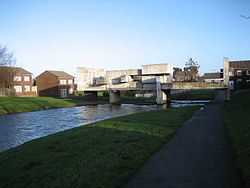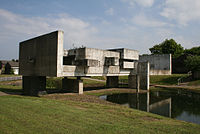Peterlee
| Peterlee | |
| County Durham | |
|---|---|
 The Apollo Pavilion | |
| Location | |
| Grid reference: | NZ430409 |
| Location: | 54°45’36"N, 1°19’48"W |
| Data | |
| Population: | 30,093 (2001) |
| Post town: | Peterlee |
| Postcode: | SR8 |
| Dialling code: | 0191 |
| Local Government | |
| Council: | Durham |
| Parliamentary constituency: |
Easington |
Peterlee is a new town in County Durham, England. Founded in 1948, Peterlee town originally mostly housed coal miners. It has strong economic and community ties with Sunderland and Hartlepool, from which towns many of the town's residents once came.
The new town
The case for Peterlee was put forth vigorously in Farewell Squalor by Easington Rural District Council Surveyor CW Clarke, who also proposed that the town be named after the celebrated Durham miners' leader Peter Lee.[1] Peterlee is unique among the new towns which came into being after the Second First World Warn that it was the only one requested by the people through their Member of Parliament, though whether a majority of the people living in the surrounding colliery villages actually wanted it to be built is disputable. It can be argued that the building of Peterlee was at the expense of such nearby colliery villages as Thornley and Wheatley Hill where development was deliberately suppressed by the local council in favour of the new town. The colliery village of Horden has, however, suffered perhaps more; its proximity to Peterlee has seen it lose all of its major services, including police and fire stations to the new town.
A deputation of working miners, met with the Minister of Town and Country Planning after the Second World War to put the case for a new town in the district. The minister, John Silkin, responded by offering a half size new town of 30,000 residents. Subsequently, they came largely from the surrounding villages in the District of Easington.
The Peterlee Development Corporation was established in 1948 under the direction of A V Williams. The original ambitious master-plan for towering blocks of flats by Berthold Lubetkin was rejected as unsuitable for the geology of the area which had been weakened by mining works and he resigned in 1950. George Grenfell Baines replaced Lubetkin and began to build quickly resulting in buildings of poor quality construction. In a bold move Williams invited an artist Victor Pasmore to be head of the design team for the landscaping. The Apollo Pavilion was completed in 1970 at centre of the Sunny Blunts estate and was named after the Apollo Space Programme. As well as a visual focus the structure acted as a bridge across a small lake. Nikolaus Pevsner provided a glowing commentary on the interaction of the housing units and the Pavilion with the landscape; however, the structure became a meeting point for unruly locals and was soon defaced with graffiti and a congregation area for drug users and drinkers. In 1982 Pasmore agreed that the connecting stairs be removed.
In 1975, Artist Placement Group had contacted new towns to set up the terms for artists to propose projects. The Development Corporation of Peterlee New Town responded and in 1976, Stuart Brisley was appointed. The project contained three distinct parts:
- to develop an ongoing process of collecting and disseminating information under the title History Within Living Memory
- to establish a publicly available history of the Development Corporation made in association with the Sociology Dept of the University of Durham
- to introduce a community workshop which began in 1977

Some local residents and councillors had petitioned to have the Apollo Pavilion demolished, citing it as an eyesore. Some locals also refer to the Pavilion as 'the Monstrosity' and an application to have the structure listed was rejected. Late in 2008 up to July 2009, the Apollo Pavilion has been revamped, with the original features such as the murals and stairs reinstated[2][3]
Parks and open spaces
Peterlee has plenty of open spaces, fields and trees, with various parks and leisure facilities.
The town is close by Castle Eden Dene, a national nature reserve.[4]
Economy
Peterlee has seen a number of changes in the last several years, this includes a bus station and also a partial indoor conversion of the shopping centre, which was given the name Castle Dene Shopping Centre. A larger ASDA supermarket was built and opened in November 2001. The old ASDA supermarket has been utilised by various retailers in 2002 including a Buckingham Bingo hall and a JD Wetherspoon public house, a Wilkinson store and a Poundworld store.
Recent redevelopments include a number of new clothes shops. New retailers have replaced the old. The town also has a range of standard chain-stores and local shops. After the removal of the old ramp and steps, a new lift and staircase were installed in the market square of the town restoring access to various shops and services on the top level. The lower deck carpark near the supermarket is used on Bank Holidays for a Market. In 2009, the town centre has recently finished further development of new shops and expansions of existing stores, and a new delicatessen and tearoom has opened recently.
Redevelopment plans within the Eden Hill area of the town are underway; Saxon Park is the name of the new housing estate. The opening of the East Durham Trust building opposite the Royal Arms Pub on Yoden Road has been part of the redevelopment of Eden Hill.
Culture
- The Peterlee Show is a two-day event held at the end of the summer holidays (usually the first weekend of September) on Helford Road Cricket Ground, which is not far from the Pasmore Pavilion.
References
- ↑ David Kynaston (2008). Austerity Britain 1945–51. Bloomsbury. p. 159. ISBN 978-0-7475-9923-4.
- ↑ Peterlee Pavilion Revamp - Sunderland Echo
- ↑ Apollo Pavilion Website
- ↑ Castle Eden Dene – Natural England
Outside links
- YourPeterlee - Community website for Peterlee and East Durham
- PETERLEE ONLINE
- myPeterlee.com
- Apollo Pavilion Website
- BBC Tees - Pasmore Pavilion photos
- Britain In Their Sites: Episode 1 (BBC Radio 4) Episode on Peterlee